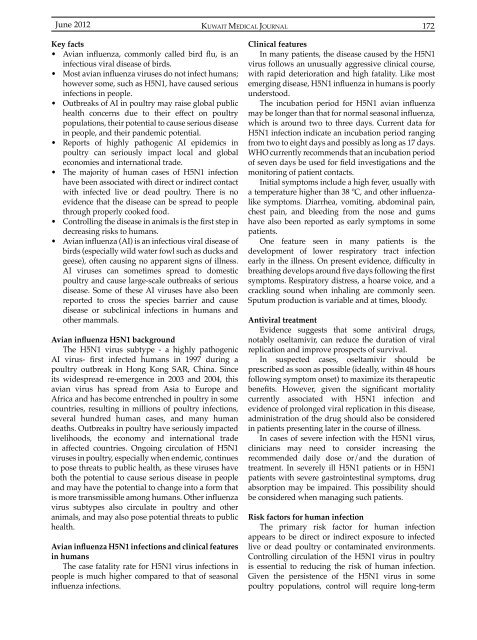Vol 44 # 2 June 2012 - Kma.org.kw
Vol 44 # 2 June 2012 - Kma.org.kw
Vol 44 # 2 June 2012 - Kma.org.kw
Create successful ePaper yourself
Turn your PDF publications into a flip-book with our unique Google optimized e-Paper software.
<strong>June</strong> <strong>2012</strong><br />
KUWAIT MEDICAL JOURNAL 172<br />
Key facts<br />
• Avian influenza, commonly called bird flu, is an<br />
infectious viral disease of birds.<br />
• Most avian influenza viruses do not infect humans;<br />
however some, such as H5N1, have caused serious<br />
infections in people.<br />
• Outbreaks of AI in poultry may raise global public<br />
health concerns due to their effect on poultry<br />
populations, their potential to cause serious disease<br />
in people, and their pandemic potential.<br />
• Reports of highly pathogenic AI epidemics in<br />
poultry can seriously impact local and global<br />
economies and international trade.<br />
• The majority of human cases of H5N1 infection<br />
have been associated with direct or indirect contact<br />
with infected live or dead poultry. There is no<br />
evidence that the disease can be spread to people<br />
through properly cooked food.<br />
• Controlling the disease in animals is the first step in<br />
decreasing risks to humans.<br />
• Avian influenza (AI) is an infectious viral disease of<br />
birds (especially wild water fowl such as ducks and<br />
geese), often causing no apparent signs of illness.<br />
AI viruses can sometimes spread to domestic<br />
poultry and cause large-scale outbreaks of serious<br />
disease. Some of these AI viruses have also been<br />
reported to cross the species barrier and cause<br />
disease or subclinical infections in humans and<br />
other mammals.<br />
Avian influenza H5N1 background<br />
The H5N1 virus subtype - a highly pathogenic<br />
AI virus- first infected humans in 1997 during a<br />
poultry outbreak in Hong Kong SAR, China. Since<br />
its widespread re-emergence in 2003 and 2004, this<br />
avian virus has spread from Asia to Europe and<br />
Africa and has become entrenched in poultry in some<br />
countries, resulting in millions of poultry infections,<br />
several hundred human cases, and many human<br />
deaths. Outbreaks in poultry have seriously impacted<br />
livelihoods, the economy and international trade<br />
in affected countries. Ongoing circulation of H5N1<br />
viruses in poultry, especially when endemic, continues<br />
to pose threats to public health, as these viruses have<br />
both the potential to cause serious disease in people<br />
and may have the potential to change into a form that<br />
is more transmissible among humans. Other influenza<br />
virus subtypes also circulate in poultry and other<br />
animals, and may also pose potential threats to public<br />
health.<br />
Avian influenza H5N1 infections and clinical features<br />
in humans<br />
The case fatality rate for H5N1 virus infections in<br />
people is much higher compared to that of seasonal<br />
influenza infections.<br />
Clinical features<br />
In many patients, the disease caused by the H5N1<br />
virus follows an unusually aggressive clinical course,<br />
with rapid deterioration and high fatality. Like most<br />
emerging disease, H5N1 influenza in humans is poorly<br />
understood.<br />
The incubation period for H5N1 avian influenza<br />
may be longer than that for normal seasonal influenza,<br />
which is around two to three days. Current data for<br />
H5N1 infection indicate an incubation period ranging<br />
from two to eight days and possibly as long as 17 days.<br />
WHO currently recommends that an incubation period<br />
of seven days be used for field investigations and the<br />
monitoring of patient contacts.<br />
Initial symptoms include a high fever, usually with<br />
a temperature higher than 38 ºC, and other influenzalike<br />
symptoms. Diarrhea, vomiting, abdominal pain,<br />
chest pain, and bleeding from the nose and gums<br />
have also been reported as early symptoms in some<br />
patients.<br />
One feature seen in many patients is the<br />
development of lower respiratory tract infection<br />
early in the illness. On present evidence, difficulty in<br />
breathing develops around five days following the first<br />
symptoms. Respiratory distress, a hoarse voice, and a<br />
crackling sound when inhaling are commonly seen.<br />
Sputum production is variable and at times, bloody.<br />
Antiviral treatment<br />
Evidence suggests that some antiviral drugs,<br />
notably oseltamivir, can reduce the duration of viral<br />
replication and improve prospects of survival.<br />
In suspected cases, oseltamivir should be<br />
prescribed as soon as possible (ideally, within 48 hours<br />
following symptom onset) to maximize its therapeutic<br />
benefits. However, given the significant mortality<br />
currently associated with H5N1 infection and<br />
evidence of prolonged viral replication in this disease,<br />
administration of the drug should also be considered<br />
in patients presenting later in the course of illness.<br />
In cases of severe infection with the H5N1 virus,<br />
clinicians may need to consider increasing the<br />
recommended daily dose or/and the duration of<br />
treatment. In severely ill H5N1 patients or in H5N1<br />
patients with severe gastrointestinal symptoms, drug<br />
absorption may be impaired. This possibility should<br />
be considered when managing such patients.<br />
Risk factors for human infection<br />
The primary risk factor for human infection<br />
appears to be direct or indirect exposure to infected<br />
live or dead poultry or contaminated environments.<br />
Controlling circulation of the H5N1 virus in poultry<br />
is essential to reducing the risk of human infection.<br />
Given the persistence of the H5N1 virus in some<br />
poultry populations, control will require long-term
















